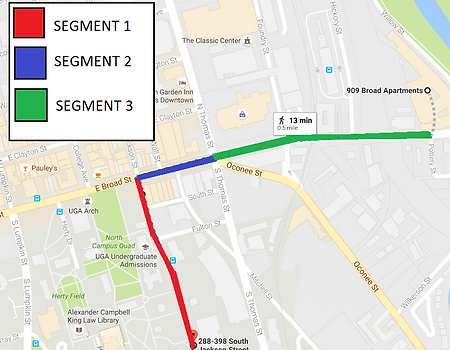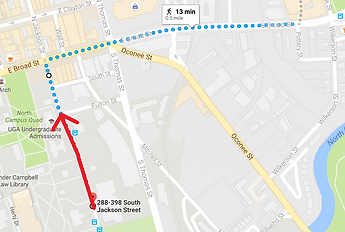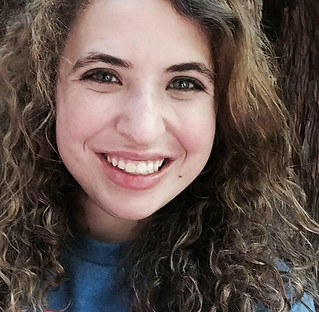
ROUTE LEAVING JACKSON STREET BUILDING TOWARDS 909 APARTMENTS






ROUTE RETURNING JACKSON STREET BUILDING FROM 909 APARTMENTS


WALKABILITY DATA & PICTURES
WALKABILITY
Route A: Jackson Street Building to 909 Broad Apartments
Route B: 909 Broad Apartments to Jackson Street Building
NEXT
NEXT


COMPARISON OF WALKABILITY PER SEGMENT


The chart above compares the average walkability percentage on both sides of the street for the route between Jackson Street Building and 909 Broad Apartments on three chosen road segments: from Jackson Street Building to the intersection of Jackson Street and Broad Street, from the intersection of Jackson Street and Broad Street to the intersection of Thomas Street and Broad Street, and from the intersection of Thomas Street to 909 Broad Apartments.
As seen on the chart, the average percent walkability is higher for each segment on the route from 909 Broad Apartments to Jackson Street Building.
For Segment 3, the route returning to Jackson Street Building is higher than the opposite side of the road due to its ample tree cover and shade, and a partial buffer between the sidewalk and road. Both sides of the street had tripping hazards, but there were more tripping hazards on the route towards 909 Broad Apartments than the other side of the street.
Click the icon to download our walkability data


CONCLUSIONS
-
The trip from 909 Apartments back to Jackson Street Building (Route B) had both of the highest walkability percentages of 76%, scoring 19 out 25 points.
-
The most important features on these segments that contributed to their walkability was the tree canopy, ample street lighting, and available areas for seating.
-
-
The trip from Jackson Street Building to 909 Apartments (Route A) had both of the lowest walkability percentages of 40%, scoring 10 out of 25 possible points.
-
The factors contributing to these low walkability scores are presence of trip hazards, lack of proper street lighting, no buffer between street and sidewalk, lack of seating, and lack of any shade or tree canopy.
-
-
The average total walkability percentage for the way to 909 Apartments was 52%, while it was 55% for on the way back to Jackson Street Building.
-
Even though these walkability percentages are very close, we personally thought the trip back was more enjoyable than the trip to the apartments.
-
Aesthetics were the main reason we enjoyed the trip back than the trip there. On the way there, a large majority of the route towards the end has major construction occurring on that side of the street, and the loud noise and unpleasant view of the construction made that segment of the trip much more unpleasant than the rest.
-
Click the icon to download our Google Earth data
For Segment 1, the route returning to Jackson Street Building contained more street lights, seating areas, and tree canopy than the other side of the street. It also had a public transit spot and a partial buffer between the sidewalk and street, making its walkability higher than the opposite side of the street.
For Segment 2, the route returning to Jackson Street Building and the route to 909 Broad Apartments have essentially the same walkability percentage, although the route returning to Jackson Street Building is slightly higher. Both sides of the street had ample lighting and tree canopy, and both had a large buffer between the street and sidewalk. The only difference making the returning route slightly higher was the presence of seating areas that the other side of the road lacked.
SEGMENT 1 :
JACKSON STREET BUILDING - INTERSECTION OF JACKSON & BROAD STREETS
SEGMENT 2:
JACKSON STREET - THOMAS/OCONNEE STREETS ON BROAD
SEGMENT 3:
THOMAS/OCONNEE STREET - 909 BROAD APARTMENTS
ROUTE LEAVING JACKSON STREET BUILDING TOWARDS 909 APARTMENTS






ROUTE RETURNING JACKSON STREET BUILDING FROM 909 APARTMENTS




ROUTE RETURNING JACKSON STREET BUILDING FROM 909 APARTMENTS


A main factor in this segment’s walkability percentages is the road segment from the intersection of Broad and Thomas streets to the intersection of Broad and Fulton Streets. On the way to 909 Broad Apartments, this particular stretch of road contained tripping hazards, few street lights, no buffer, no tree canopy, and a poorly maintained residential building. On the opposing side of the street, this particular segment contained ample tree canopy and street lighting, a large buffer between the road and sidewalk, and a well maintained commercial building. This particular segment shows how one side of the street can be much more walkable than the other side of the street.
ROUTE LEAVING JACKSON STREET BUILDING TOWARDS 909 APARTMENTS


On the way to 909 Apartments
From Thomas/Broad intersection
to Fulton/Broad intersection
On the way from 909 Apartments
From Fulton/Broad intersection
to Thomas/Broad intersection
CONCLUSION
In conclusion, we believe that the most important factors that affect walkability are lighting, surrounding use, and public amenities. The biggest factor is light, both having some sort of protection from it during the day, and being provided with enough of it to feel safe and to be able to get around at night. Following that is what the surrounding area is used for. The areas that have prospering businesses have a much safer and pleasant atmosphere, usually with more plants for aesthetics and as buffers, than those beside residential units, largely rentals, that are minimally maintained and lack a feeling of community. Finally, having access to public transportation and/or places to sit and rest improves the walkability of an area by giving people a reason to be there, and a comfortable place to wait before moving on to their destination.


WALKING ROUTE















